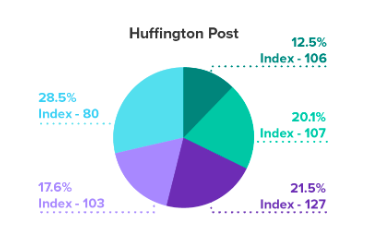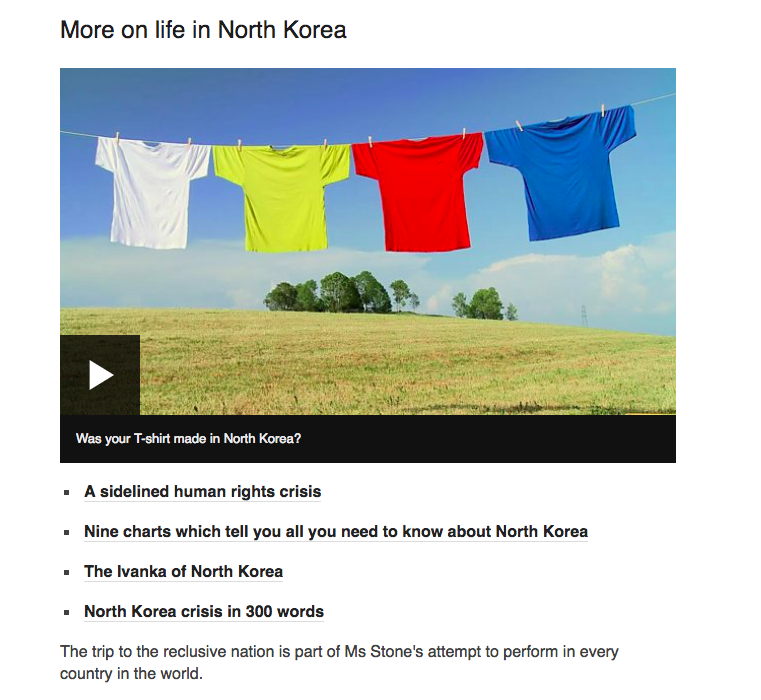
Biographical Survey Of HuffPost UK:
The Huffington Post was founded in 2005 in America, with localized and international editions. It is a digital-born online publication. Website content used from both paid staff writers and reporters, and unpaid bloggers. It is an online news service depends on advertising. By 2018, nearly 100000 unpaid bloggers from aspects of the entertainment brokerage made a contribution for the web site. But after a lot of fake news spread, HuffPost ends unpaid contributor program in 2018.
HuffPost UK is one of 15 global editions of HuffPost, which was founded in 2011. This version was under tremendous pressure at the beginning of its creation because the British media market already has a lot of good bloggers and publishing platform. HuffPost UK’s goal is to show innovation in a rich and thriving culture and create a lot of interesting conversation sparks.
Target user group



From the above pictures, we can see that the proportions of male and female audiences are almost the same. And the ages of the target reader are older. The proportion of people over 55 years old is the highest, which is 28.5%.
HuffPost has a number of domain names, of which huffingtonpost.com is the most popular. According to Alexa, it’s global ranking is 513. However, huffingtonpost.co.uk ranks far behind. Furthermore, the audience of HuffPost UK is mostly distributed in the UK. So the services in different places target different groups of people, which could help to integrate the local situation and expand the audience.
Journalism writing analysis:

This is a news report about a British singer’s concert around the world. The headline has the ‘entertainment’ tag, which clearly indicates that the story is entertaining. The title uses several question marks to make the news more interactive.
The author uses the “inverted pyramid” structure. She puts the important information first and then tells the reader the details of the story. The reporter wrote this short story in the third person, that she doesn’t convey personal feelings in this article. Although it does not give the reader a mind of feeling, it conveys the message objectively and directly.

The story has not been linked to other relevant reports, but it has direct referenced the parties’ discourse, which is highly credible.
The content of the article is not very detailed. The reporter did not introduce the singer’s relevant information, readers may be curious about this. And the part of North Korea and Syria concert was a little bit messy. If it is with a subtitle that would have been nice.

The two tags for the story are “UK music” and “Joss Stone.” I think it will be more searchable to add some place names, such as North Korea.
Online delivery analysis
“If you are a journalist, there is no real personal (or even private) account.” (Bradshaw, 2018). There is a link which connects to other articles the reporter has written and her Twitter page. In addition, it can also use for interacting with the reporter to complete the interactivity of the web page.
Hyperlink does not open as a new page. Instead, it changes the original webpage into the new link. Most of the readers may not want to go back to the original article.

When I clicked on the link of Joss Stone, it showed me other reports about her tour than some personal information about her. The article would be more readable if a reporter could make the distinction between the link contents clearer.
The report also embeds the Instagram link, which allows readers to tap directly into a singer’s home page or see related images via tags. On the left side of the page, there are logos of Facebook, Twitter, etc., which can be clicked to share the content of the article.

The bottom of the article has a special link to send suggestions through a private email account. This page will automatically select the signup morning email. This is also a marketing strategy to get the email address and push news messages to readers.
“Good news, whether informative or sensational, always creates dialogue.” (Bradshaw, 2018 ) Comments can be posted at the bottom of the post via the readers’ Facebook account.
Technical analysis:
This page is in black and white which makes the visibility clear. Each of the links is valid, and other social platforms are plugged in, as well as a gallery for easy playback. The paragraphs are neatly arranged and easy to read. Both the title and subtitle could grab the reader’s attention.
At the top of the page are links to other platforms of HuffPost UK’s home pages. There are also different types of news button on the top of the webpage, which indicates the navigation clearly. The webpage is clear, and readers can easily get the information they are interested in. Overall, HuffPost UK is a mature media platform.
Biographical Survey Of BBC Online News
BBC is the oldest national broadcaster in the world. BBC online news is the news website of the BBC, which is a very popular news site in the UK. BBC online news was established in November 1997 and is a legacy media site. On a global scale, there are nearly 14 million readers per month. In 2015, the software of BBC online news was launched. It allows content to be automatically adjusted to fit a variety of screen sizes, from desktops to smartphones. Most of the news reported came from TV reports, and some authorized users post articles. It is a government enterprise, and most of it is funded by the government. It only supports the language of English.
Target user group

According to Alexa, its ranking is 96 in worldwide. A lot higher than HuffPost UK. its audience is mainly distributed in the European region.

From the data in SimilarWeb, audiences are interested in TV radio and social network, news and media and newspapers. So far, it has been visited a total of 522.68million times, with an average of four minutes and fifty seconds per visit. Facebook is the largest social network sending traffic to BBC online news. It is worth mentioning that the load speed of the website is very slow.
Journalism writing analysis:
This is a very short news report. The title of the article does not attract the audience, it only states the thing and has no subtitles. The content of the article is short and scannable, and it is easy to read.
However, the article does not have links for readers to follow up on other reports of this tour. Same as HuffPost UK, it doesn’t have a subtitle for splitting the article, which makes the article logic less clear. But it has photos and videos to break down text blocks.

It has a video link, which adds to the multi-linearity of the article. There is an ad splitting the story. Below the ad is an Instagram image. Continuous images may disturb the reader’s continuity. Before the end of the article, there are another video and four news links, which are not related to this report. It makes readers feel confuse.
The author mentioned the singer’s concert in Syria. It would be better if there is more relevant information. The final content of the article is the restrictions of the US government and the British government on going to North Korea. I think this part of the content should be in front, allowing readers to get important information before losing attention.
Online delivery analysis
There is no information about the author in the report. “The two-way relationship between users and between users and journalists” (Nguyen 2008). There are links to social media platforms below the title that can be used to share articles on different platforms. More users also report sharing digital news than creating it, making online news ‘sharing’ a more significant form of cultural production than citizen journalism.
The article embeds Instagram, which is easier to open the singer’s home page to view related content. That enhance the storytelling of the story and fit the theme. There is a report button under each Instagram link that can give suggestion to editors of the news. However, after opening it, it needs to fill in a lot of information and it looks complicated.
Unlike HuffPost UK, it has no comment interface. Without a dialogue medium, the platform will lose the opportunity to understand the reader.

The article uses the form of a link to get the relevant video. If the video directly on the page, it will widen the interaction. It is worth mentioning that the article has no links to relevant reports. At the bottom of the page are other news stories, but they are irrelevant to this news.
Technical analysis
All links to technical delivery reports can be opened, and the content of the articles is well distributed and legible. The top of the page is a different channel for BBC online news, which is easy to navigate. And there are dedicated Asian buttons to serve the community more clearly. But compared with HuffPost UK, there are not link to other social platforms of HuffPost UK’s homepage. The multimedia used in the report is very simple and easy to read.

There is a list of popular stories on the right side of the page. It is released on time to make it easier for readers to learn more about the news.
Conclusion:
The BBC online news page is more concise, the classification is clear, but it lacks some interactivity. In general, it is a more traditional media platform. HuffPost UK’s pages are much richer and have more sections. And from the content of the report, it is also more detailed, more satisfying BASIC principles.
Reference:
Bradshaw, P. (2018). ’Writing for Social Media & Chat Apps. In The Online Journalism Handbook: Skills to survive and thrive in the digital age. (pp. 99–133). Routledge.
Bradshaw, P. (2018). Writing for the Web. In The Online Journalism Handbook: Skills to survive and thrive in the digital age (pp. 72–98). Routledge.
Bradshaw, P. (2018). Finding Leads and sources online. In The Online Journalism Handbook: Skills to survive and thrive in the digital age (pp. 51–71). Routledge.
Huffington Post (HuffPost). (2019). Retrieved from https://www.influencewatch.org/for-profit/huffington-post/
HuffPost | Description, History, Content, & Facts. (2019). Retrieved from https://www.britannica.com/topic/The-Huffington-Post
Nguyen, An (2008) ‘Facing the “fabulous monster”: the traditional media’s fear-driven innovation culture in the development of online news’, Journalism Studies, Vol.9 no.1, pp. 91–104.
Levine, J. (2019). HuffPost Ends Unpaid Contributions in Break With Past. Retrieved from https://www.thewrap.com/huffpost-ends-unpaid-contributions/
Hwong, C. (2019). Chart of the Week: Tracking Audience and Reader Demographics. Retrieved from https://www.vertoanalytics.com/chart-week-tracking-news-reader-demographics/
The Huffington Post launches in the UK. (2019). Retrieved from https://www.thedrum.com/news/2011/07/06/huffington-post-launches-uk
bbc.co.uk Traffic Statistics. (2019). Retrieved from https://www.similarweb.com/website/bbc.co.uk
Changing the face of the BBC News website. (2019). Retrieved from https://www.bbc.com/news/uk-41890165


Be the first to comment